





Mirror, mirror of the pond, which is the fairest rain lily in the world?
(Editor's Note: This article was originally published on September 29, 2009.)
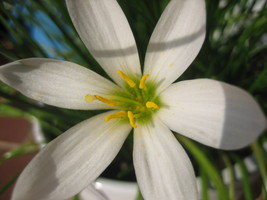 Paraphrasing the famous question of the witch queen from the "Snow White" fairytale, I'm introducing you in the magical world of the Zephyranthes. This beautiful bulb has several popular names like rain lily, fairy lily and Zephyr lily, all talking about its magic. It's not a real magic, but it always surprises! Zephyranthes has an abundancy of blooms after every rain and the flowers are growing so quickly, they seem to appear from nowhere, like in magic made with a rainy spell! [1] And since the Zephyr is the western wind which brings the rain, they called the plant "Zephyranthes" - the plant that needs the Zephyr to blow and bring the rain so she can bloom.
Paraphrasing the famous question of the witch queen from the "Snow White" fairytale, I'm introducing you in the magical world of the Zephyranthes. This beautiful bulb has several popular names like rain lily, fairy lily and Zephyr lily, all talking about its magic. It's not a real magic, but it always surprises! Zephyranthes has an abundancy of blooms after every rain and the flowers are growing so quickly, they seem to appear from nowhere, like in magic made with a rainy spell! [1] And since the Zephyr is the western wind which brings the rain, they called the plant "Zephyranthes" - the plant that needs the Zephyr to blow and bring the rain so she can bloom.
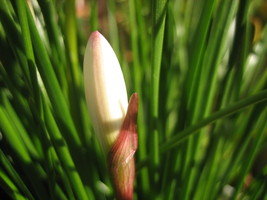 This delicate plant with thin leaves, looking more like a herbaceous plant than a bulb, is attractive not only for the bees, but also for people. Its flowers are white, pink, yellow or other colors resulted from hybridizing. Most of them have a delicate fragrance. If you didn't know they were Zephyranthes, you could easily mistake them with the crocuses because of the flower's shape which face upward.[2]
This delicate plant with thin leaves, looking more like a herbaceous plant than a bulb, is attractive not only for the bees, but also for people. Its flowers are white, pink, yellow or other colors resulted from hybridizing. Most of them have a delicate fragrance. If you didn't know they were Zephyranthes, you could easily mistake them with the crocuses because of the flower's shape which face upward.[2]
In our country it is also called the 'Lily Flowers Grass'.
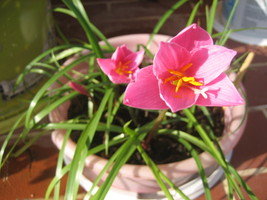
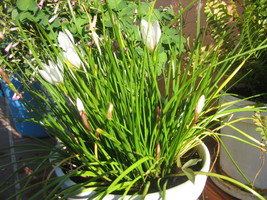
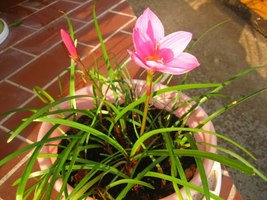
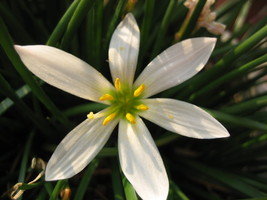
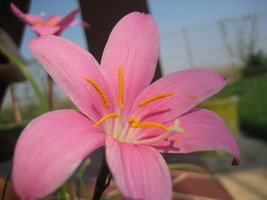 Zephyranthes genus is from the Amaryllidaceae family and has about 70 species, but only a few can be grown indoors. It is native to Southeastern U.S., and Central and South America.[3]
Zephyranthes genus is from the Amaryllidaceae family and has about 70 species, but only a few can be grown indoors. It is native to Southeastern U.S., and Central and South America.[3]
If you are living in the U.S. zones 7 through 10 you can plant the Zephyranthes bulbs in the garden and keep them during winter .

You can divide the bulbs in the fall or in spring. They can multiply by seeds too, but only if they are sowed as soon as the pods get yellow and the seeds are black, not later. If the seeds are allowed to dry, they will germinate much later, even after a year.

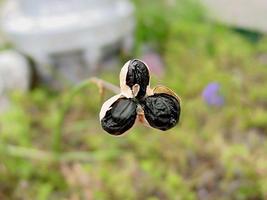


 From zone 6 north, the bulbs have to be dug out and kept indoors in sand during the winter. In spring, you can replant the bulbs in the garden, in a sunny place. If you choose to plant Zephyranthes in containers, you won't have to dig them out before the first frost, just bring them inside the house and keep them in a cool place, watering a bit every few days.[4]
From zone 6 north, the bulbs have to be dug out and kept indoors in sand during the winter. In spring, you can replant the bulbs in the garden, in a sunny place. If you choose to plant Zephyranthes in containers, you won't have to dig them out before the first frost, just bring them inside the house and keep them in a cool place, watering a bit every few days.[4]
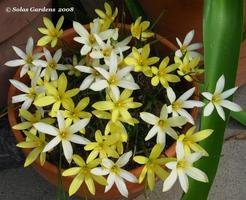
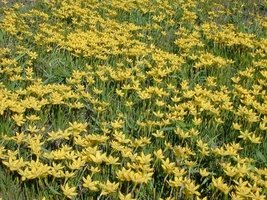
They are spectacular when planted in groups in your garden, but they have to be divided to increase blooming.
Zephyranthes grandiflora is the most common rain lily. It blooms all summer and its flowers are pink. The color of the flowers fades the next day and they look like having a different color.
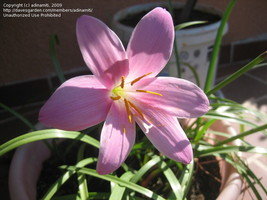
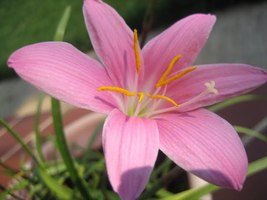
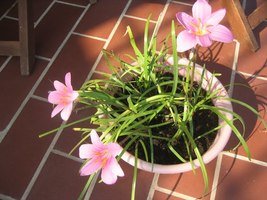
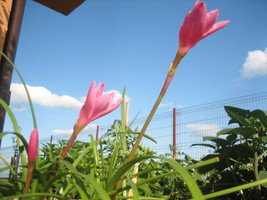
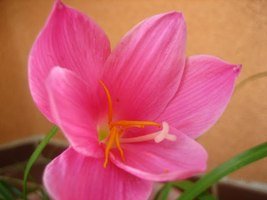
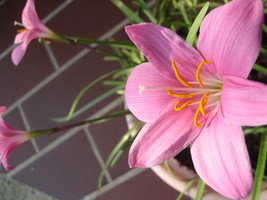
Zephyranthes candida, also called the 'Brazilian crocus', has smaller white flowers and blooms at the end of the summer and early fall. It can be hardy even farther north than zone 6, if planted near the house or if they are covered during winter to prevent freezing.
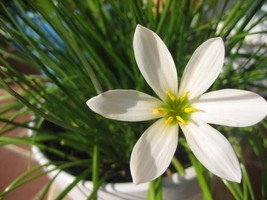
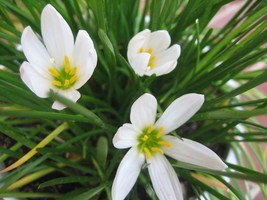
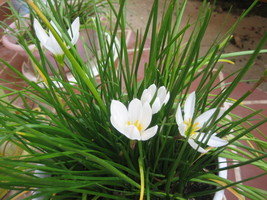 I've learned this from my own experience with Zephyranthes. My mother gave me these two plants with thin, long leaves. One was blooming all summer and had pink flowers, while the other one had white flowers and wasn't blooming until the end of summer. Later on, when I repotted them, I found out they were bulbs. I've always loved them because their flowers were so sweet and brought such delicacy to my balcony with their pink and white colors! While the one with the white blooms has beautiful green foliage all year, the one with the pink blooms always keeps losing its leaves especially during winter. I've now learned that they are Zephyranthes grandiflora and Zephyranthes candida, the best-known species in my country from this genus.
I've learned this from my own experience with Zephyranthes. My mother gave me these two plants with thin, long leaves. One was blooming all summer and had pink flowers, while the other one had white flowers and wasn't blooming until the end of summer. Later on, when I repotted them, I found out they were bulbs. I've always loved them because their flowers were so sweet and brought such delicacy to my balcony with their pink and white colors! While the one with the white blooms has beautiful green foliage all year, the one with the pink blooms always keeps losing its leaves especially during winter. I've now learned that they are Zephyranthes grandiflora and Zephyranthes candida, the best-known species in my country from this genus. 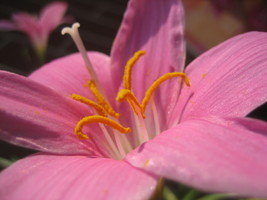
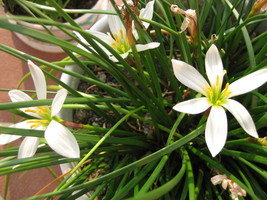
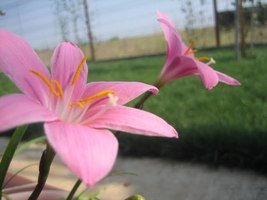
Recently I found out they are more species of different colors, many of them being hybrids. I have now bulbs from Zephyrantes citrina and Zephyrantes reginae, which were sent to me by a very good friend of mine.
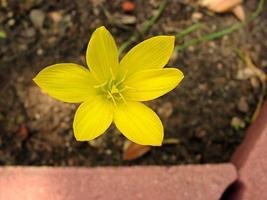 Zephyranthes citrina (syn. Z. sulphurea) has yellow flowers which have a nice fragrance and don't fade color like most Zephyrantes do.
Zephyranthes citrina (syn. Z. sulphurea) has yellow flowers which have a nice fragrance and don't fade color like most Zephyrantes do.
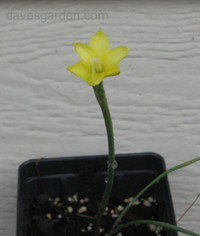
Zephyrantes pulchella has a bit more color than citrina.
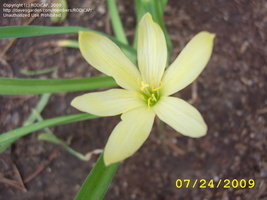 Zephyrantes reginae (Queen's Rain Lily) has yellowish flowers, but thinner petals.
Zephyrantes reginae (Queen's Rain Lily) has yellowish flowers, but thinner petals.
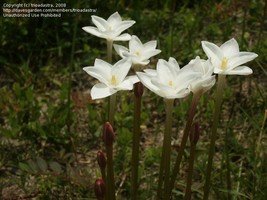 Zephyranthes traubii has the tallest stalks and white flowers.
Zephyranthes traubii has the tallest stalks and white flowers.
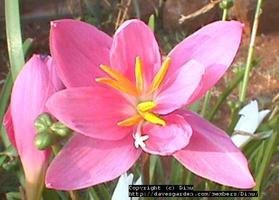 Zephyranthes rosea has smaller flowers with 8 petals, different from the other Zephyranthes, which have 6 petals blooms.
Zephyranthes rosea has smaller flowers with 8 petals, different from the other Zephyranthes, which have 6 petals blooms.
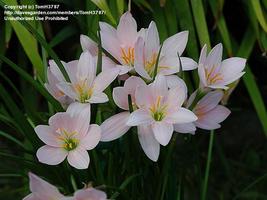
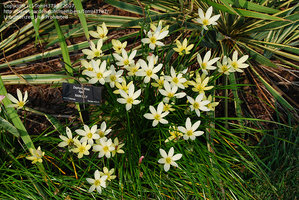 Many hybrids were obtained, like Zephyranthes 'Ajax' which is a hybrid between Zephyranthes citrina and Z. candida. It opens yellow and fades to white the second day.
Many hybrids were obtained, like Zephyranthes 'Ajax' which is a hybrid between Zephyranthes citrina and Z. candida. It opens yellow and fades to white the second day.
Zephyrantes 'Grandjax' is a hybrid between 'Ajax' and Z. grandiflora.
Zephyrantes 'Java', 'Krakatau' and 'Tenexio Apricot' have a beautiful coral-apricot color.
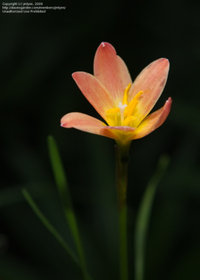
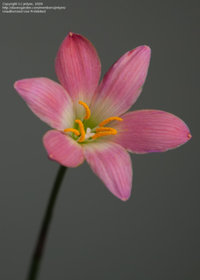
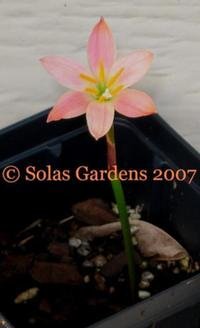
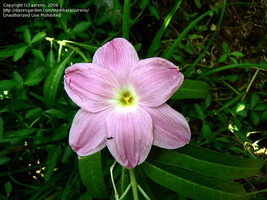 Zephyranthes 'Pink Panther' is a cute hybrid between Zephyranthes grandiflora and Z. traubii.
Zephyranthes 'Pink Panther' is a cute hybrid between Zephyranthes grandiflora and Z. traubii.
Very similar to Zephyranthes' flower, also classified in the same family are Habranthus and Cooperia flowers.
Habranthus is different from the Zephyranthes because it holds its flowers in an angle rather than upright.[5]
Another difference is that the Zephyranthes has equal stamens, while the Habranthus has unequal stamens.[6]
Hybridizers have obtained many Habranthus hybrids of different colors.
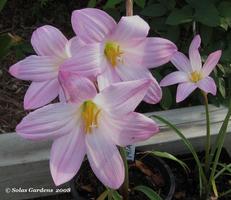
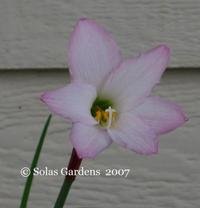 Habranthus robustus(Argentine rain lily) 'Russel Manning' has large blooms and shorter leaves.
Habranthus robustus(Argentine rain lily) 'Russel Manning' has large blooms and shorter leaves.
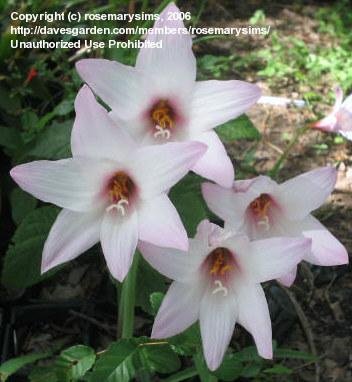
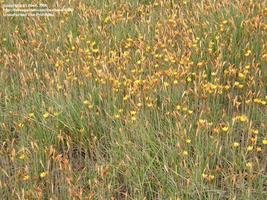 Habranthus brachyandrus looks very much like Hippeastrum and has a beautiful touch of fuchsia color at the bottom of the flower, inside and out.
Habranthus brachyandrus looks very much like Hippeastrum and has a beautiful touch of fuchsia color at the bottom of the flower, inside and out.
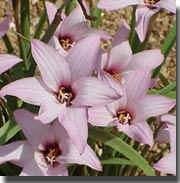 Habranthus 'Cherry Pink' hybrid is a very popular hybrid of Habranthus robustus and Habranthus brachyandrus.
Habranthus 'Cherry Pink' hybrid is a very popular hybrid of Habranthus robustus and Habranthus brachyandrus.

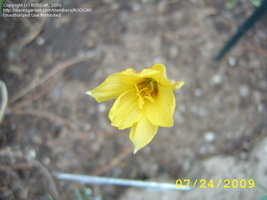
Habranthus tubispathus is also called Copper Lily because of the flower color.
Cooperia is a desert wild plant related to Zephyrantes. It has a fragrance similar to primerose and a tolerance to drought and desert conditions.[7] It is a nocturnally blooming plant, unlike the Zephyranthes which blooms at mid-day.
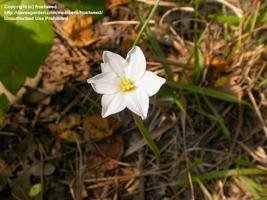 Cooperia drummondii (syn. Cooperia chlorosolen or Zephyrantes chlorosolen) is a common rainlily with white petals.
Cooperia drummondii (syn. Cooperia chlorosolen or Zephyrantes chlorosolen) is a common rainlily with white petals.
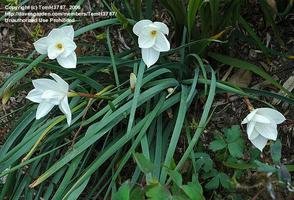
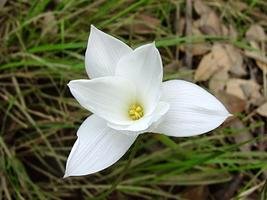 It is oftenly mistaken with Zephyrantes drummondii, also known as Chebolleta, the evening-star rain lily and the giant prairie rain lily. It can reach 18 inches height and has a beautiful flower with the appearance of a star because of the star arrangement of the petals and sepals - all the same - thus they are called tepals.[8] Very rarely Chebolleta has 2 blooms from a single bulb.[9]
It is oftenly mistaken with Zephyrantes drummondii, also known as Chebolleta, the evening-star rain lily and the giant prairie rain lily. It can reach 18 inches height and has a beautiful flower with the appearance of a star because of the star arrangement of the petals and sepals - all the same - thus they are called tepals.[8] Very rarely Chebolleta has 2 blooms from a single bulb.[9]
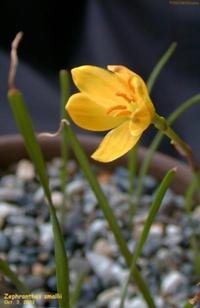
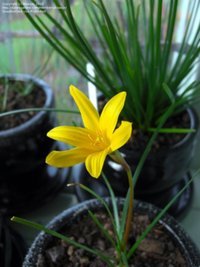 Cooperia smalli or Zephyranthes smalli, is a natural hybrid of Zephyrantes pulchella and Zephyrantes chlorosolen.[11]
Cooperia smalli or Zephyranthes smalli, is a natural hybrid of Zephyrantes pulchella and Zephyrantes chlorosolen.[11] According to another source, Cebolleta is Cooperia drummondii.[10]
Let us enjoy the beauty of these magical flowers and let the botanists make up their mind.
Many thanks for allowing me to use their beautiful pictures to our DG friends: htop, triodastra, Dinu, TomH3787, jmlynn, Lophophora, klaasje, kdjcl, dmj1218, rosemarysims, BuriedTreasures, dbell, azreno and frostweed.
For more information, check the Daves Garden Plantfiles.
[1] Gaygardener.com
[2] & [4] Gardenguides.com
[3] eFloras.org
[5] Wikipedia
[6] Pacific Bulb Society
[7]Wikipedia
[8] Jstor.org
[10] Tamu.edu
[9] & [11] eFloras.org
Copyright © www.100flowers.win Botanic Garden All Rights Reserved